Travel and Culture: Two weeks along the Pacific Coast Highway from LA to Seattle Part 3- Seattle Washington
By Cornelia Seckel
ART TIMES Summer 2016
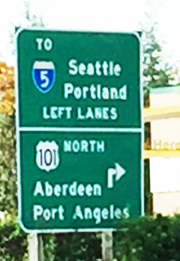 Seattle just a few miles away |
~ Part 1 of this series was published in the Winter 2015 issue of ART TIMES. Click this link and read it online
~ Part 2 of this series was published in the Spring 2016 issue of ART TIMES. You can read it online.
We arrived in Seattle, our final destination. The purpose of coming to Seattle was to visit Muriel Bressler, family friend (lived across the street from Little Neck, NY) for over 60 years. For many years I’d been thinking about visiting Muriel and combining it with a visit with childhood friend Leta Nadler and Heidi Robertson in LA and to see my niece Elliana Spiegal in SF and then to head to Seattle to see Muriel. On my last birthday I again thought about this trip: should I drive ? fly? combine flying and driving? and then it hit me that Muriel was going to be 97 and WHAT WAS I WAITING FOR??? So I wrote to Heidi who was soon to retire to see if she was up for a road trip and she was. It was a fabulous trip with lifetime memories and joy sharing this time together.
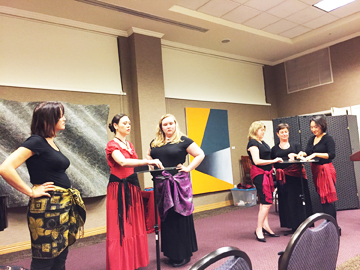 Ladies Music Club of Seattle |
After a brief visit with Muriel’s son Steven and his wife Janek we decided to stay with Muriel at the University House, a retirement home where she has been living since she left New York. What a wonderful gift to ourselves and to Muriel who is loving, appreciative, interesting and interested in the world. We laughed, drank wine, visited with her friends — one of them a former resident of Woodstock and we had many people we knew in common— and just enjoyed her company. I’ve known Muriel for 60 years but in this brief time together learned so many more things to appreciate about her. One night we went to the evening’s entertainment a performance of French operatic favorites performed by the Ladies Musical Club (LMC) of Seattle. The voices were excellent and I particularly liked the suggestion of costumes and props as they sang arias from Carmen, Manon, Guillame Tell and other well-known operas. This group was founded in 1891 by 24 women musicians who decided they wanted to bring Seattle into national status as an American city that valued great music. Today 150 women offer free music and education programs throughout Seattle in schools and public venues to people of all ages and diverse backgrounds. Each year the club sponsors a competition for emerging classical artists ages 20-35 from the Northwestern states and California. Winners are awarded cash-prizes and present concerts in communities in WA state that have limited access to live classical music. For more about the Club and this competition: LmcSeattle.org
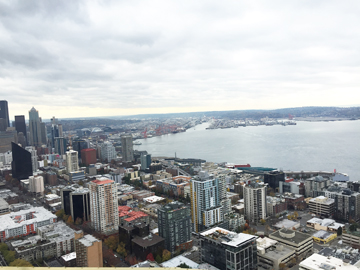 Seattle skyscape from the top of the Space Needle |
Of course while we were in Seattle we went to the Space Needle, the Chihuly Garden and Glass and Pike’s Market.
The Space Needle, known around the world, is the symbol of Seattle and was built for the 1962 Seattle World’s Fair. The artist Edward E. Carlson was inspired by the Stuttgart Tower, when he was there in 1959 and his original design did have to go through numerous revisions before the tower was completed in 1962. Heidi and I took the elevator to the top and the observation deck up 520 feet where we had a 360˙ wonderful view of Seattle, even if it was a gray and rainy day. Walking around the observation deck we saw the outline of the Cascades, the boats and ferries on Elliot Bay and the city of Seattle. An interesting display in the observation deck was a map of the world where visitors could key in their information. At that point, 56,715,766 visitors had signed in since 1962.
In the same complex is the Chihuly Garden and Glass.
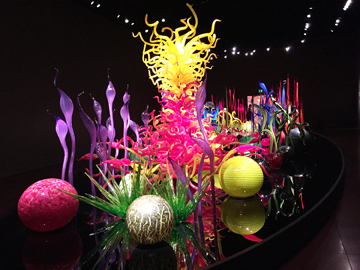 Mille Fiore Dan Chihuly |
Dan Chihuly is an American glass sculptor and entrepreneur. His works are considered unique to the field of blown glass, as many of his works are large-scale sculpture. He does installations and environmental artwork and that is what we were seeing at the Chihuly Garden and Glass. I hadn’t been a fan of what I’d seen of Chihuly’s work but felt that I was in Seattle and “should” go — it would be like being in Paris and not going to the Eifle Tower. I am so glad that I went. I was mesmerized from the time I stepped into the outdoor garden with fabulous glass “flower” sculpture throughout. Once we went into the galleries we saw amazing sculptures and installations. In some ways I felt like I was floating through another world, as we saw the Persian Ceiling, The Glass Forest and Ikebana and Float Boat, Mille Fiori, Italian for “a thousand flowers.” I could have been looking at the ocean floor with the vast plant life. This garden of glass with so many different shapes and forms has many different styles of work. According to the signage about the construction “he relied less on tools and more on the use of fire, gravity and centrifugal force.” These installations went way beyond Chihuly’s glass tubes that I’d previously seen. In the Northwest Gallery were baskets, rugs, and photographs of Native Americans of the southwest shown along with beautiful blown glass “baskets” very reminiscent of the place and materials of the actual baskets— all quite magnificent. After an accident that left him blind in one eye and then in 1979 a dislocated shoulder, Chihuly could no longer hold the glass blowing pipe. He describes his role since then as "more choreographer than dancer, more supervisor than participant, more director than actor." He writes: “I want people to be overwhelmed with light and color in a way they have never experienced.” I surely was and, it appeared, were the many different people of various ages and ethnic groups visiting.
We were hungry and went to the Collections Café where we had a scrumptious lunch. In the café were many of Chihuly’s collections including: Keys, Ceramic Dogs, Bottle Openers, Vintage Christmas Ornaments, Fly-Fishing Poles and Reels, African Necklaces, Pocket Knives, Accordions, Tin Toys and many, many more. Apparently he began collecting when he was a small boy and hasn’t stopped.
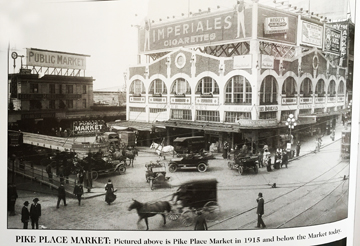 Pikes Market photo from 1917 |
This was our last day and quite a full one. From the Space needle and Chihuly Garden and Glass we headed to Pike Place Market.
Pike Place Market was opened in 1907 so that farmers could sell their produce directly to consumers. Well over 100 years later this market continues to grow and now encompasses a nine-acre Market Historic District overlooking Elliott Bay with well over 250 independent businesses: produce, art and collectibles, clothing and accessories, restaurants and food stalls, flowers, bookstores, and a host of market and community services.
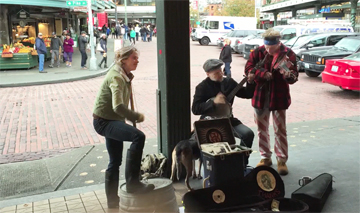 Buskers at Pikes Market, Click to see video |
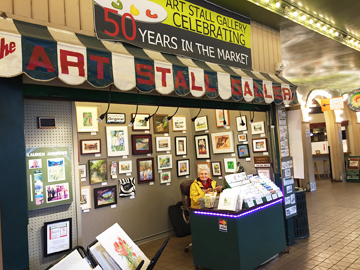 The Art Stall Gallery at Pikes Market |
There are street performers, artists and craftspeople having one of the largest craft markets in the country featuring all locally made handcrafted goods and a gallery that has been at Pike Place Market since 1964.
The Art Stall Gallery, a cooperative gallery of 14 professional painters, opened in 1964 and became involved when there was a movement to demolish the Market for commercial development. I was pleased to meet Lauren Andrews who told me about the Gallery, a stall with works of their members on display. There is a great commitment by vendors to offer quality goods and produce and more. When I asked, vendors spoke very highly of being part of the market. A quarterly newspaper, Pike Street Times, serves as a guide to the Market as does the extensive website pikeplacemarket.org. This landmark of Seattle has over 10 million visitors a year. Pike Place Market is also a neighborhood with more than 400 residents, many, low-income seniors. I must say we tried but didn’t succeed to see the entire market but we did get to the original Starbucks.
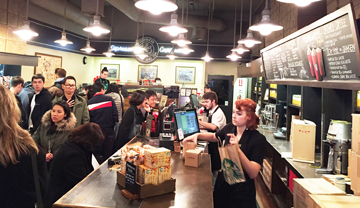 The original Starbucks at Pikes Market in Seattle, Washington |
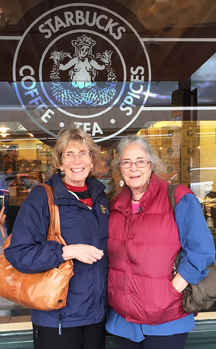 Heidi and Cornelia |
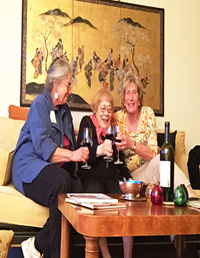 a farewell toast with Muriel a farewell toast with Muriel |
Our last meal with Muriel Bressler a dear family friend and the reason we came to Seattle. I feel such gratitude to have had this time with her and to have had 2 glorious weeks with Heidi.
Heidi got me to the airport in time for my flight (the only time commitment we had for our entire trip) and it was difficult to say good-bye for now. I’m
sure we’ll be heading out on another road trip in the future. My trip home on the redeye (now I get why they call it the redeye) was uneventful. Now that I
am back in the office I have memories of a glorious road trip and am pleased to be able to share it. So many times Heidi and I told people we met that we
were on this road trip and had been friends for 60 years. I believe we inspired several of them to do the same with old friends as perhaps you will.
This report plus more about the trip can be read on my blog: Culturally Speaking Journal
Share |
